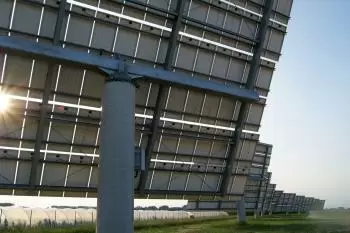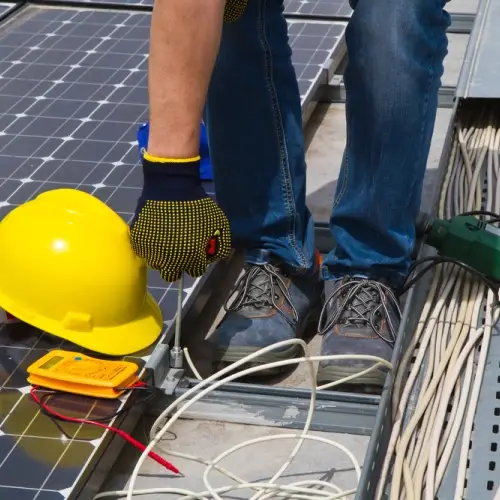
Active solar energy encompasses solar collection systems that employ mechanical or electrical devices to boost the efficiency of solar panels and to convert the captured solar energy into electrical or mechanical energy . These devices include fans, water pumps, and solar trackers, among others.
In contrast, solar systems that do not make use of such devices are classified as passive solar energy systems, which directly harness solar radiation.
An example of active solar energy is a solar tracker . Solar trackers are occasionally used to improve the performance of photovoltaic panels by keeping them constantly oriented towards the sun.
How does active solar energy work?
Active solar energy is a system that captures, stores and distributes the sun's energy using mechanical or electrical devices for use in heating, cooling and power generation.
 Unlike passive solar energy, which relies on architectural design and materials to optimize solar gain, active solar energy uses specific technologies to maximize its efficiency.
Unlike passive solar energy, which relies on architectural design and materials to optimize solar gain, active solar energy uses specific technologies to maximize its efficiency.
One of the main methods of harnessing this energy is through photovoltaic solar panels , which convert sunlight into electricity using photovoltaic cells. This electricity can be stored in batteries or injected directly into the electrical grid.
Another method is solar thermal energy , which uses solar collectors to heat a fluid (water or air), which is then used for heating, hot water or industrial processes. Thermal systems can be low, medium or high temperature, depending on their application.
To optimize their operation, these systems usually include pumps, fans and electronic controllers , which regulate the transfer of heat or electricity. They can also incorporate solar trackers , which adjust the orientation of the panels to maximize the capture of radiation.
Active solar architecture
Active solar architecture is a branch of architectural design that focuses on the incorporation of specific systems and technologies to capture and use solar energy directly.
Unlike passive solar architecture, which focuses on arranging architectural elements to maximize natural light and heat gain, active solar architecture involves technological components that convert solar radiation into usable energy, such as electricity or heat.
These active systems may include photovoltaic panels to generate electricity from solar radiation, solar thermal collectors that capture solar heat for water heating or space heating applications, and solar tracking systems that dynamically orient solar panels to follow the sun's path during the day and maximize energy capture.
Types of active solar energy
Active solar energy can be photovoltaic and thermal.
Solar thermal energy
Solar thermal energy uses direct solar radiation to generate heat. In general, this type of energy is used to supply hot water. However, solar thermal power plants use this technology to generate electricity - so-called solar concentrators.
Domestic hot water and active solar heating
Domestic hot water (DHW) systems without thermosiphon use water pumps and other elements to circulate water within their circuits.
In thermosiphon systems, water circulation is achieved by the difference in density between hot and cold water. In this case, these systems do not require external mechanisms and are classified as passive solar energy systems.
Orientation of solar collectors
Most solar collectors are placed on fixed supports facing south. The angle is calculated so that they can capture the greatest amount of radiation at all times. But these collectors would be more efficient if they could change their orientation with respect to the Sun at any given time.
Concentrated solar energy
In the case of concentrated solar energy, it is necessary to install solar tracking systems. This type of installation requires focusing the solar radiation received on a single point. To achieve this, the mirrors have to adapt their inclination in relation to the position of the Sun.
The function of this type of system is used in solar thermal power plants with the aim of generating electricity.
Photovoltaic solar energy
Active solar photovoltaic energy is clearly an active system. Photovoltaic panels are responsible for generating electricity. The transformation into electrical energy takes place in the photoelectric cells that make up the module.
The generated energy then passes through transformers and other external elements.
To increase efficiency, we can orient the solar panels with the help of an electric motor. The optimal performance of a solar panel is obtained when solar radiation falls perpendicularly.
These installations are often converted into hybrid solar power plants. A hybrid solar system is a solar system that receives energy support from other energy sources. In this case, the energy source can be an electric generator or other renewable energy sources such as wind power.
Differences between active and passive solar energy
Active solar thermal can have higher solar savings fractions than passive systems due to better heat transfer and transport.
An interesting hybrid method is to use a solar panel to operate pumps or fans. Data analysis, using heat thermodynamics software, can be used to compare the results of various active and passive solar strategies.
Passive solar systems do not require additional energy to operate and therefore have zero maintenance costs. They also emit no greenhouse gases so they do not contribute to worsening climate change.
Comparison between active and passive solar energy: advantages and disadvantages
| Aspect | Active Solar Energy | Passive Solar Energy |
|---|---|---|
| Efficiency | Greater efficiency, as it uses technology (panels, pumps, fans) to maximize energy capture and distribution. | Less efficient, as it depends on the architectural design and location of the construction. |
| Initial investment | High investment for equipment and installation (solar panels, batteries, pumps, etc.). | Lower initial cost, as it is based on design strategies such as orientation, insulation and thermal materials. |
| Climate dependence | It can be affected by cloudy days, although energy storage mitigates this problem. | Completely dependent on climate and location, with no possibility of active storage. |
| Maintenance | Requires periodic maintenance (cleaning of panels, checking of batteries and mechanical equipment). | Minimal maintenance, only depends on the condition of the construction and its materials. |
| Versatility | It can be used in any type of building and even in areas without connection to the electrical grid. | Limited to buildings specifically designed with passive solar principles. |
| Applications | Electricity generation, heating, cooling and hot water. | Passive thermal regulation in buildings (ventilation, natural lighting, thermal comfort). |
| Environmental impact | Low environmental impact, but involves the manufacturing of panels and batteries, which require specific materials. | Almost zero environmental impact, since it does not use mechanical or electrical equipment. |